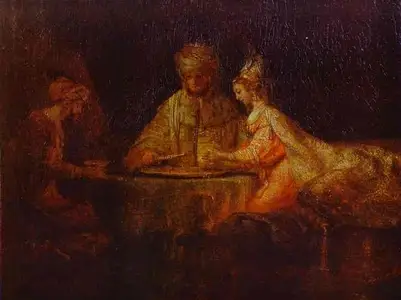Title of Artwork: “Ahasuerus (Xerxes), Haman and Esther”

Artwork by Rembrandt
Year Created 1660
Summary of Ahasuerus (Xerxes), Haman and Esther
The artwork Ahasveros and Haman at the Feast of Esther is one of the rare works by Rembrandt van Rijn whose provenance is established. In 1662, the painting’s genesis was discovered, just two years after it was completed.
Book of Esther chapters 5-7 is used as the focus of this essay. Proposals to hang Mordechai and the entire Jewish people were made by Haman, a counsellor to Ahasuerus, the king of Persia, as retribution for their vanity.
With the help of Mordechai’s cousin Esther, the wife of Ahasuerus, the Jews were rescued. In the Jewish festival of Purim, this rescue is remembered. Rembrandt’s portrayal of Haman reflects the festival’s portrayal of him as the villain.
All About Ahasuerus (Xerxes), Haman and Esther
A masterpiece of Rembrandt’s late years, according to the Pushkin Museum.
To create the feast of Esther, Rembrandt was influenced by Johannes Serwouters (1623-1677)’s play Hester. For the first time in 1659, the playwright was staged at the Schouwburg van Campen in honour of Joan Huydecoper van Maarsseveen’s daughter, Leonore Huydecoper. As a response to Eastern European pogroms, Serwouters penned his play. Rembrandt’s financial situation may have been helped by her husband’s purchase of the picture.
Ahasuerus and Haman at the Feast of Esther was painted by Rembrandt in 1660 and sold to Jan J. Hinlopen in 1661. It was in the year 1662 that Jan Vos released a poetry book in which he included several poems based on paintings by Jan J. Hinlopen. According to Jan Vos, the artist who created the work,
Among the pieces that Jan Hinlopen’s daughters inherited from his collection, this painting was one of them. Sara Hinlopen, the family matriarch who lived to the ripe old age of 89, passed away alone and childless. Nicolaes Geelvinck and his three sisters received the bulk of her possessions when she went away in her sleep. Because she undoubtedly didn’t want to pay estate taxes on the picture, she left it out of her will.
After the death of Gerard Hoet, a minor painter but prominent collector in The Hague, the auction of Ahasuerus and Haman at the Feast of Esther was held in 1760.
Catherine the Great acquired the picture in 1764, most likely via the bankrupt German industrialist Johann Ernst Gotzkowsky. The Russian Tsarina began the Hermitage after receiving 320 paintings from Gotzkowsky at once.
Gustav Friedrich Waagen may have been the one who recommended the painting’s transfer to Moscow’s Museum Rumyantsev in 1862. Since 1924, ‘Ahasuerus and Haman at the Feast of Esther’ has been on display in the Pushkin Museum in Moscow, where it has remained ever since.
Information Citations
En.wikipedia.org, https://en.wikipedia.org/.























